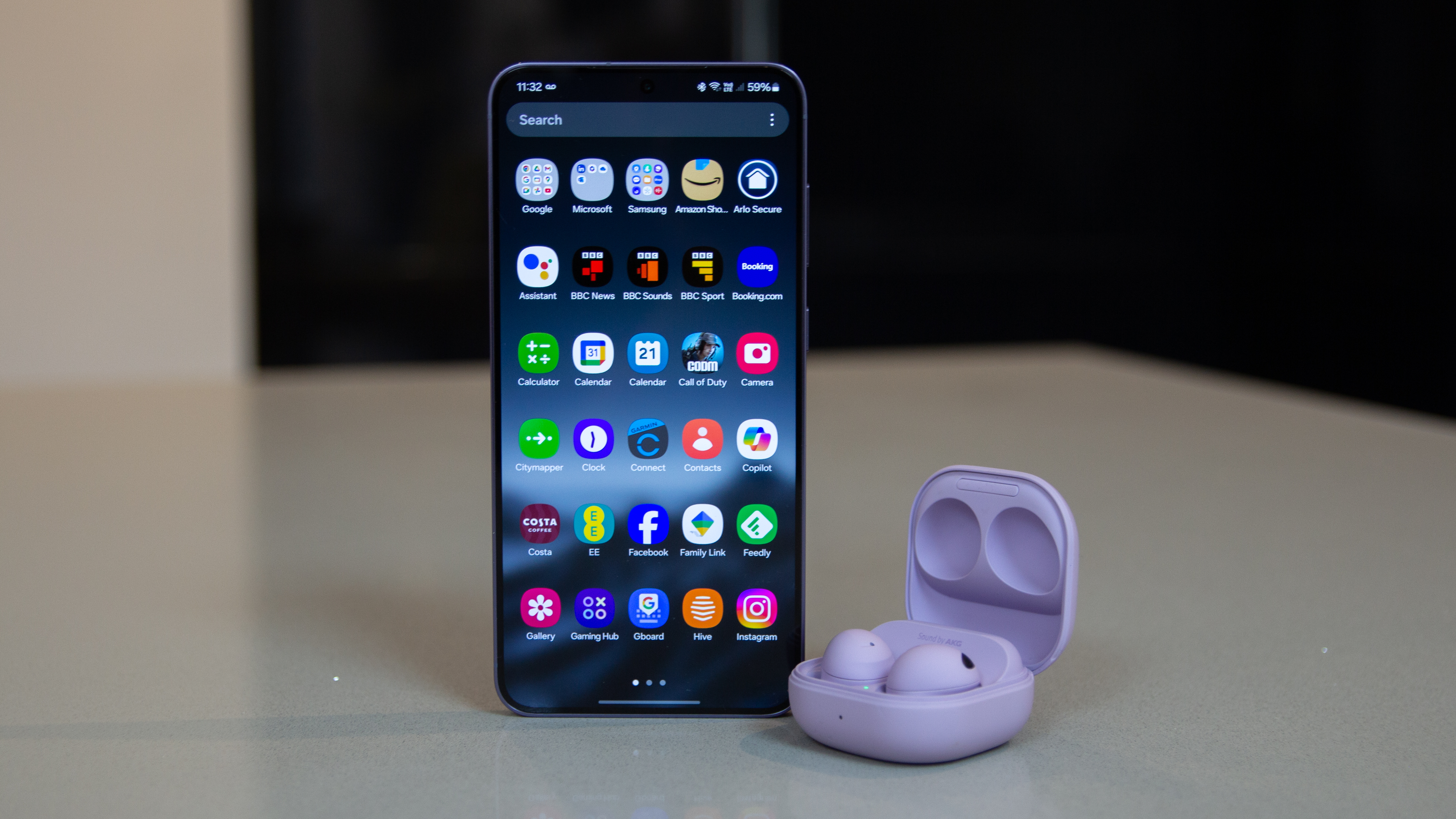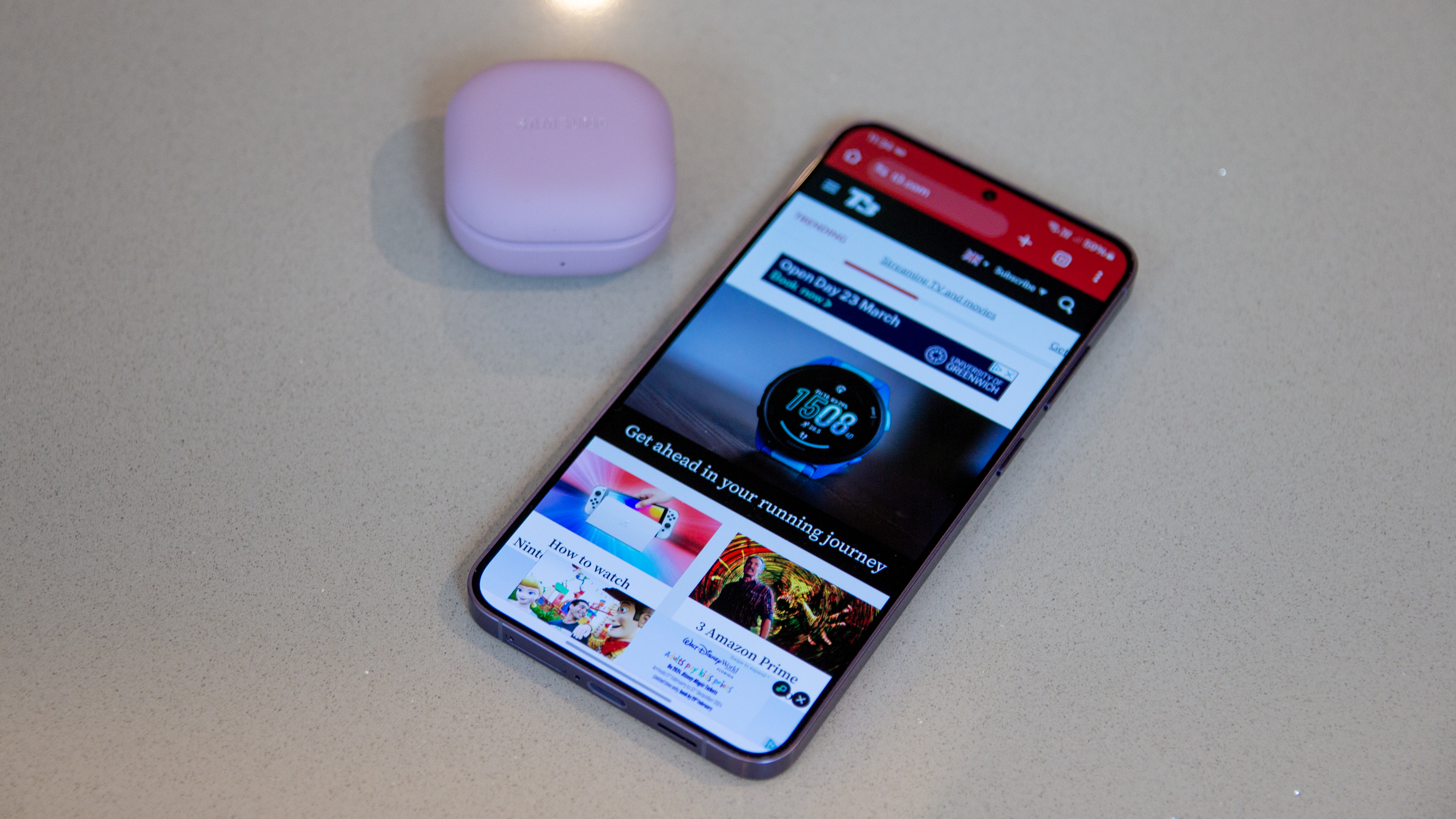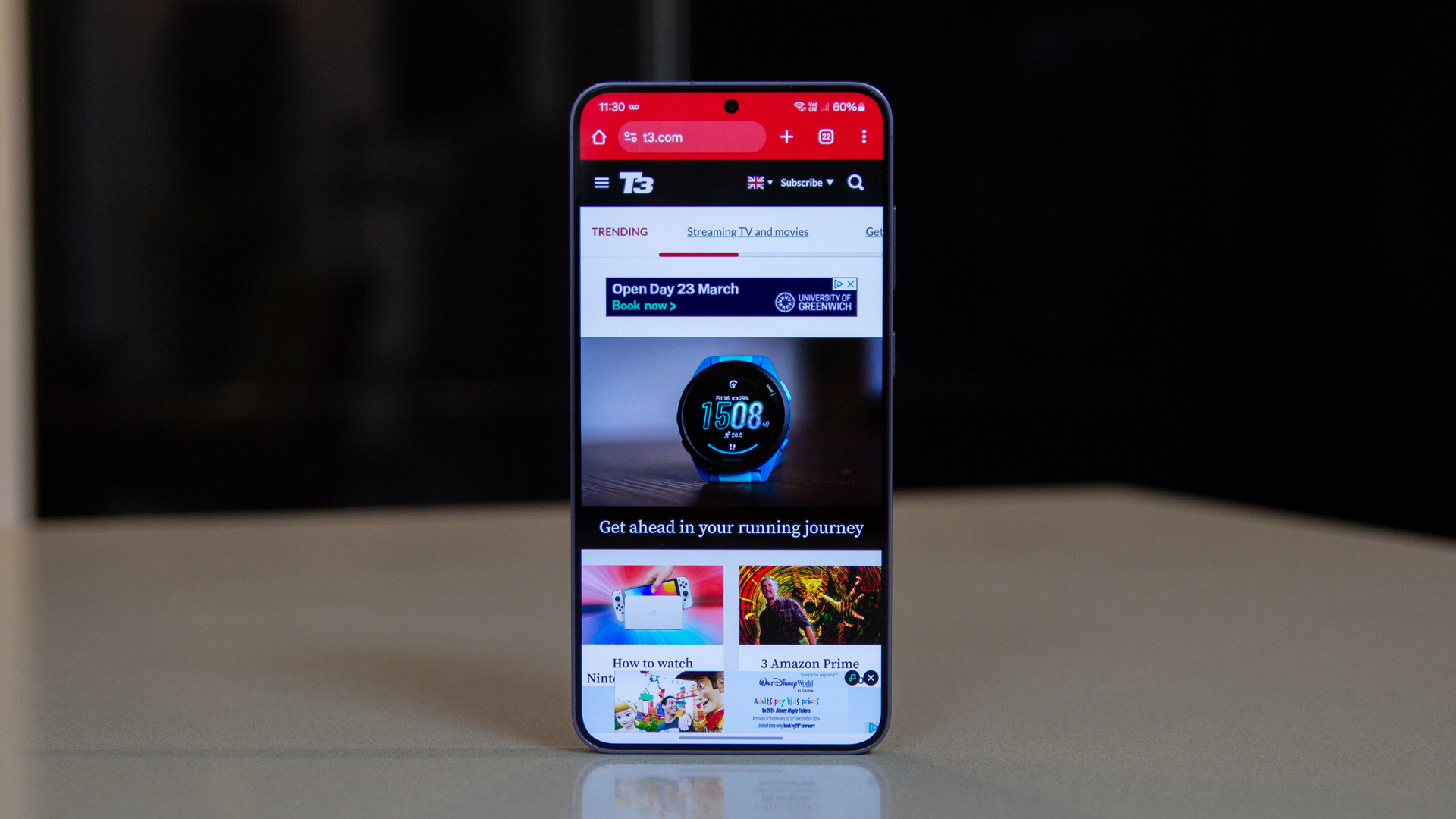Samsung Galaxy S24 Plus review: the most sensible choice?
The Galaxy S24 Plus sits in the middle of pack of the three S24 handsets, but might be the pick of the bunch. Here's why:


The Samsung Galaxy S24 Plus is a great all-round device offering plenty of power, decent battery life and a comprehensive camera offering. The display has had a technical boost for this generation, although the lack of vibrancy lets the side down a little. The introduction of Galaxy AI adds some interesting options to the company's already comprehensive One UI, making this Android phone a joy to use – especially if the entry-level S24 is too small for your wants.
-
+
7 years of updates future-proofs this Galaxy
-
+
Flat-frame design is now iconic Samsung
-
+
Lots of power and efficiency
-
-
Upgraded display doesn't actually look better
-
-
Cameras need to chase the competition
-
-
Most of the AI lives in Galaxy apps
Why you can trust T3

Samsung's flagship Galaxy S24 family falls into three distinct models: there's the S24 Ultra that steals all the headlines; the regular Galaxy S24 that's most compact and most affordable; the Galaxy S24 Plus, as reviewed here, which sits in the middle of the pack – and as it's neither the top-end nor the cheapest it's often the hardest sell.
But look beyond the appeal of the Galaxy S24 Ultra and you'll find that the Galaxy S24 Plus has a large display, premium design and lashings of performance, giving this phone plenty of potential. Pair that with a comprehensive camera assembly, new internal hardware, the same Galaxy AI treatment as found on the Ultra model, and your interest should be piqued.
So how does it all hang together? Is the Plus actually the pick of Samsung's S24 family and one of the best phones of 2024, or is this still an awkward middle child that misses out on all the attractiveness of its siblings?
Samsung Galaxy S24 Plus: Price & availability
The Samsung Galaxy S24 Plus took a slight drop in price over the S23 Plus to make it more attractive in the UK. It's priced from £999 / $999 / AU$1699 for the 256GB model.
The Samsung Galaxy S24 Plus is widely available, but there are some exclusive colours available from Samsung's online store, while those who ordered promptly will get themselves a free pair of Samsung Galaxy Buds 2 Pro thrown in.
But while it's cheaper than last year, there's still a lot of competition out there: the Google Pixel 8 Pro can be snapped up for the same price, while the OnePlus 12 is cheaper – and all these devices occupy the same space in the market.
Samsung Galaxy S24 Plus review: Features & What's new?

- Squared frame
- Galaxy AI features make their debut
- Samsung Exynos 2400 chipset (for UK & EU)
- QHD+ resolution, 2600 nit display with smaller bezels
At first glance, the Samsung Galaxy S24 Plus doesn't land with a wide range of changes over the previous device. Indeed, it's easy to point at the phone, highlight that it has the same camera setup and basically the same overall design, and think that nothing has changed.
Get all the latest news, reviews, deals and buying guides on gorgeous tech, home and active products from the T3 experts
From a quick glance, yes, these phones are hard to tell apart, but the devil is in the detail. The big change is the shift from slightly rounded sides for the Armor Aluminum frame to a squared form. This gives a sharper and slightly more modern look to the S24 Plus, but it's also closer in design to recent iPhone models, such as the iPhone 15 Pro.
That means it's sharper in the hand, something you might not notice on the smaller Galaxy S24, but once you're wrapping your fingers around the 75.9mm girth of this phone, you'll feel it. It's actually fractionally narrower than the Galaxy S23 Plus that it replaces, but it's not as soft to hold given the tweaked design. Note that you don't get the titanium frame of the Galaxy S24 Ultra here.
The display increases in visible size fractionally because the bezels are now slightly narrower, but Samsung has also bumped the display resolution on the Galaxy S24 Plus to QHD+ (that's 1440 x 3120 pixels), making it sharper than ever before. It's also brighter, at 2600 nits, which should, notionally, bring a number of advantages.
There are a couple of other technical changes to note: the battery has a 100mAh increase in capacity, and it's powered by the Samsung Exynos 2400 in some regions (hi there UK readers), losing the Snapdragon power that all the Galaxy S23 offered globally.

It's really the introduction of Galaxy AI that marks the Galaxy S24 family apart from previous devices. Galaxy AI – Samsung's suite of artificial intelligence leveraged features – swings into a couple of elements of the device, allowing translation on phone calls or in messages, enabling AI assistance on messaging, or to help with Notes. This is a fairly basic interpretation of content to correct, reformat or summarise, the sort of thing that we see Microsoft Copilot or Google Gemini doing.
The Voice Recorder offers to use AI to transcribe what was said – and will identify different speakers – but it doesn't happen live, so it's not as immediately impressive as Google's Recorder app. However, it will also summarise, so if you record a lot of meetings it could be useful – but definitely needs a human eye for accuracy.
These Galaxy AI features are interesting but not immediately groundbreaking. And there's a downside: you need to use Samsung's apps for said features to work. That means in messages you need to use the Samsung Keyboard, which is a poor imitation of Google's Gboard when it comes to typing. Essentially, Samsung is boosting its own apps, and some might just skip those apps and use stock Google ones instead.
Circle to Search is the most useful feature, allowing you to circle anything on the display and get a Google search result for it. That was the AI feature that took all the headlines at launch – and it then landed on the Google Pixel 8 too, so it's useful, but not unique to Samsung.
Samsung Galaxy S24 Plus review: Design & Display

- Colours: Cobalt Violet, Amber Yellow, Onyx Black, Marble Grey
- Flat 6.7-inch AMOLED panel, 2600 nits max brightness
- 1440 x 3120 resolution and 1-120Hz refresh rate
- IP68 water/dust resistance
I'm not going to dwell too much on the design of the Galaxy S24 Plus because I've mentioned the major changes above. What's important to take away is that there's an interesting range of colours to choose from, and it keeps those elements offered by the Galaxy S23 Plus, like the IP68 protection – adding peace of mind if the phone gets wet or dirty.
The display change is more significant. Samsung has switched up the technical ability of this panel, bumping the resolution to 1440 x 3120 pixels (for a sharp 512ppi – sharper than the iPhone). But that's not where the story ends for this display: set it next to the Galaxy S23 Plus and you'll find that the display just isn't as vibrant.
Head into the display settings and the difference between natural and vibrant is practically non-existent. Fire up Netflix and at the same brightness level the Galaxy S23 Plus looks better, with greater vibrancy in the visuals. The S24 Plus with its potential for greater HDR performance (thanks to the higher 2600 nit peak brightness) should look better, but it doesn't to my eyes.
This is something of talking point, with Samsung claiming this was deliberate. That was the same argument we heard from Google back in 2017 when the Pixel 2 XL launched with a dull display – something that was subsequently fixed via software update. Some might prefer a duller look (which is what the 'natural' display setting is for) – but to my eyes the lack of vibrancy detracts from one of the main reasons for buying a Samsung phone in the first place.
Vibrancy aside, this display technically should be a better performer than those that have come before it – the greater peak brightness is great not just to deal with reflections on sunny days, but also for punching out HDR visuals. That is something the Google Pixel 8 Pro excels at, and Samsung currently doesn't seem to be delivering those rich visuals to the same degree. Hopefully, Samsung will address this with a software update.
Samsung Galaxy S24 Plus review: Performance & Battery

- Samsung Exynos 2400 processor (UK & EU), 12GB RAM, 256/512GB storage
- 4900mAh battery, 45W wired charging, 15W wireless
Samsung has reverted back to using Exynos in some flagship devices. Having offered Snapdragon hardware in all the Galaxy S23 devices globally, we now see the return of Exynos in the Galaxy S24 and S24 Plus in Europe, rather than the Snapdragon 8 Gen 3 found in the Galaxy S24 Ultra (for all regions). The Exynos 2400 is backed by 12GB RAM, with storage options of 256 or 512GB.
Exynos doesn't have the consumer appeal that Snapdragon does and generally speaking, it can't match Snapdragon's performance in the best gaming phones, but it's a close-run thing. Dismissing this phone because it is Exynos would certainly be a mistake – and most users would struggle to find anything to complain about. I've found the Galaxy S24 Plus to be a perfectly good performer, with no sign of lag in daily use.
During extended gaming sessions on Call of Duty: Mobile I've found the phone to warm, but not to worrying degrees. Samsung equipped the S24 models with more capable cooling specifically to deal with these sorts of things. And the larger frame should mean it's even better than the smaller-scale 'baby' S24 model below it in the range too.
Battery life is generally good, too, with the Galaxy S24 Plus getting a capacity bump so it's nearly as capacious as the S24 Ultra. Certainly, I had no worries about getting through the day, unless getting stuck into heavy camera use or heavy gaming – but that's the same on all phones. On some occasions I used the phone through the full day and didn't charge overnight – and still had enough to get through half the following day.
Charging is still pretty slow though: at 45W wired it's nothing to get excited about compared to something like the OnePlus 12 with its 100W charging, but this is what Samsung does. Wireless charging continues at 15W – again that's fine for a passing top-up, but it's not the speediest. Also note that there's no charger in the minimal packaging.
Samsung Galaxy S24 Plus review: Cameras

- Main (24mm): 50-megapixel, f/1.8 aperture, optical stabilisation (OIS)
- Zoom (3x, 70mm): 10MP, f/2.4, OIS
- Wide (13mm): 12MP, f/2.2
Samsung is pushing two elements with the camera: there's the full suite of lenses on the phone, then the added dimension of Galaxy AI wanting to help you out and make your photos better. Like the other AI features of this phone, you need to be using Samsung's Gallery app to access them, and to use Generative Edit, you might need to enable it in the advanced settings on your phone first.
This will give you more power to edit, with generative AI filling in backgrounds where you remove them or if you rotate a photo for example. It's pretty easy to select photo elements to make these edits and the results are pretty good – but it doesn't feel as though it has the flair of Google's Magic Editor, which does a lot more for you, like identifying skies or water and offering to replace them.
Elsewhere, the performance of the camera is essentially the same as it was on the Galaxy S23 Plus. That was a good camera, decent in most conditions. The 50-megapixel main camera is the star, able to capture great images in wide-ranging conditions – and there's a repeat performance here.







Photos are generally nicely balanced: if you want them to have a natural look you can toggle off the 'scene optimiser' function, although when this is on it will make images look richer, with greener grasses and bluer skies. Night photos are respectable, giving longer exposures to capture more in dull conditions.
The front camera will cleverly illuminate your face in low-light so you can at least see yourself, while portrait modes have no problem picking out an edge and blurring the background.
There's a difference in colour temperature between the ultra-wide and the main cameras which can bring some inconsistency when switching between lenses. The zoom range runs to the 3x optical lens, after which you're using digital zoom and the quality drops off progressively. Samsung's 30x Space Zoom isn't anything to get excited about, as it's quite mottled, so best not to stray over 10x if you can avoid it.
Nothing here is really new, but it's still a good all-round smartphone camera offering. The AI features in my experience don't deserve as much attention as they get on Google's Pixel phone, but there's still some easy editing options here.
Samsung Galaxy S24 plus review: Verdict

The Samsung Galaxy S24 Plus takes two steps forward and one step back. From a design point of view it's an evolution over the Galaxy S23 Plus, with a welcome performance boost and decent battery life. The charging is still a little slow, but I wouldn't say that's a deal-breaker.
The display is more puzzling: on the spec sheet, it should be a highlight of the phone, but once compared to the older phone or indeed some contemporaries, it just doesn't feel like it delivers on its billing. Samsung could make this phone stronger by making the vibrant screen mode more vibrant, so that those who want it, can have it.
But in the order of Galaxy S24 options the Plus is still a solid option: it's larger than the 'baby' S24 and doesn't cost as much as the stylus-equipped S24 model. Those seeking a flagship Galaxy phone will be happy with this middle option, but the competition certainly hasn't made the choice easy.
Also consider
The OnePlus 12 is the most recent launch that might rival the Galaxy S24 Plus in this position. It's more affordable and it comes at a similar size with loads of power and decent battery life.
Alternatively, if it's AI that you're after, then the Pixel 8 Pro remains the AI phone of the moment. It offers a great camera experience, impressive Magic Editor performance, and a great display. It's perhaps not quite as powerful and the battery life isn't anything special, but it's a great phone overall.

Chris has been writing about consumer tech for over 15 years. Formerly the Editor-in-Chief of Pocket-lint, he's covered just about every product launched, witnessed the birth of Android, the evolution of 5G, and the drive towards electric cars. You name it and Chris has written about it, driven it or reviewed it. Now working as a freelance technology expert, Chris' experience sees him covering all aspects of smartphones, smart homes and anything else connected. Chris has been published in titles as diverse as Computer Active and Autocar, and regularly appears on BBC News, BBC Radio, Sky, Monocle and Times Radio. He was once even on The Apprentice... but we don't talk about that.